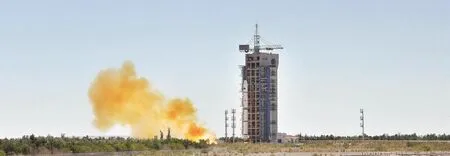PRSS-1 Successfully Launched and Technological Breakthroughs Achieved
2018-02-20DFHSatelliteCo.Ltd
The LM-2C carrier rocket successfully launched the Pakistan Remote Sensing Satellite 1 (PRSS-1) at 11:56 Beijing time on July 9, 2018. The satellite will be used for Pakistan in such fields as land and resources survey, assessment, dynamic monitoring and management, resources utilization, environmental disaster monitoring, agricultural survey and urban construction. It will consolidate the China-Pakistan friendship and serve the construction under the Belt and Road Initiative.
After 24 months of hard work, the satellite development team has overcome technological difficulties and made breakthroughs in related fields for China.
The design significantly improves image quality. Image quality is a core indicator of the in-orbit application for remote sensing satellites. The mass solid-state storage (4 Terabits) and independent image processing (two independent data processors) technologies applied to the PRSS enabled the design to be optimized so that two independent cameras can process, store and download images independently with tighter and better image data compression based on the “mass image data” (panchromatic: near-lossless; multi-spectral: lossless). In this way,final images can better conform to the “original images” and be clearer. It meets the special requirement of the international customer for “high image quality”.
In addition, it improves the micro-vibration environment of the cameras and significantly mitigates the jitter from the whole satellite. Therefore, the imaging quality has improved. In order to alleviate the impact of changes of the star sensor’s optical axis on imaging quality, a high-precision integrated star sensor is used for the satellite. In addition, thermal deformation control has been optimized. Successful application of “high-precision temperature control technology for the camera system” with star sensor control promotes the positioning accuracy of targets without control points and makes cameras operate on selected objects in a more accurate manner.

The LM-2C launch vehicle is soaring up into space
Furthermore, the development team carried out a frozen orbit design and optimized the offset of the initial descending node to enable the satellite to observe the specific areas from a stable orbit height and ensure proper lighting for the cameras.As a result, the customer can obtain quality images of specific areas.
The design and verification of a series of initiatives to improve image quality have been unanimously recognized and highly credited by the French Consultant and the Pakistani Supervisor: “the design is sophisticated, the validation is valid, and the result is satisfactory”.
The satellite is capable of side-sway and pitch with very large angles to meet the requirement of the Pakistani customer for fast acquisition of target images. It means that the satellite can automatically “look up”, “look down”, and “look right and left”and sway in four directions, i.e. forwards, backwards, rightwards and leftwards to expand the visible range of cameras and greatly enlarge the imaging area, and thus fulfill the function of fast acquisition of Pakistani territory images once every two days.
The satellite has a de-orbiting capability designed as per international standards. In light of the international space convention, satellites must adopt a de-orbiting design to prevent them becoming “space garbage” at the end of their service life. In order to meet this requirement, an attitude and orbit control subsystem was designed and fuel was calculated in detail so that the satellite is capable of positive and extensive maneuver change of orbit at the end of its service life. After de-orbit has been initiated, the satellite can gradually descend its orbit by fully utilizing the “passive orbit descending” property of the thin air and finally fall into the atmosphere and be burn out within 25 years after de-orbit is initiated.
The satellite has a full-link information security capability.According to the requirements of the Pakistani customer for the satellite information security, a full-link information security design was made for PRSS-1. To ensure information security of the satellite-ground link image data and control, the telemetry,remote control and image data of the satellite are all provided with an encryption function. The encryption algorithm specified in international standards is applied to image data. Both a plain working mode and encrypted working mode can be used. With these efforts, the Pakistani customer is provided with more open and convenient means for data security protection.

The PRSS-1 is preparing for launch
The satellite has a design life hitting a new high among the low-orbit remote sensing satellites exported by China. The satellite has a design life of 7 years, the longest among the loworbit remote sensing satellites exported by China. Key product technologies such as long-life batteries, solar array drive mechanism, spot beam antenna, momentum wheel, and gyroscope are used for the satellite to allow it to have a long life and high reliability. To meet the customer’s requirement that the satellite must have an in-orbit service life of 7 years, the products mentioned above were all subject to special life tests or have longlife in-orbit flight experience.
The satellite is the first exported satellite equipped with a device furnished by a foreign customer. To satisfy the Pakistani customer, the satellite is equipped with the Customer Furnished Instrument (CFI) independently developed by Pakistan. It is the first one among the low-orbit remote sensing satellites exported by China. With the careful design by the development team,the satellite platform provides the CFI with interfaces for power supply, remote control and telemetry, and CAN bus data transmission. In addition, to protect the whole satellite from the adverse impact caused by CFI faults in extreme cases, the development team carried out a targeted safety design for the power supply and information interfaces so as to ensure fault isolation.
杂志排行
Aerospace China的其它文章
- Intelligent and Autonomous Flight Technology for Launch Vehicles
- LM-11— The Main Force in China’s Small Launch Vehicles for Commercial Launch
- LM-11SL: A Sea-Launched Carrier Rocket for Small Satellites and Its Launch Service
- QB50 Project and the Development of CubeSat Technology in China
- CAASSE Signed a MOU with HASSE
- Welcome to the First China International Symposium on Microsatellite
